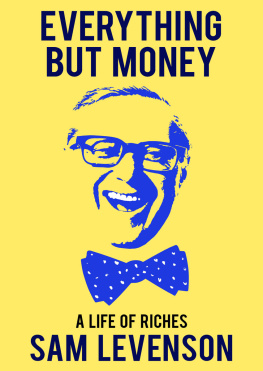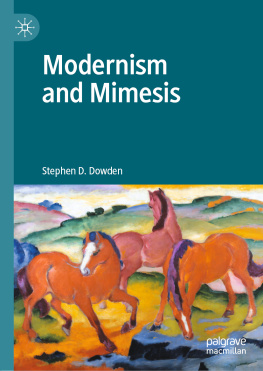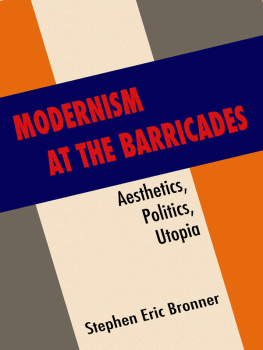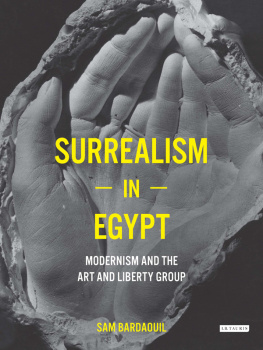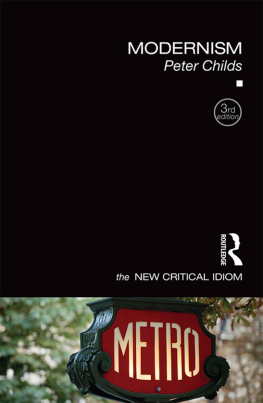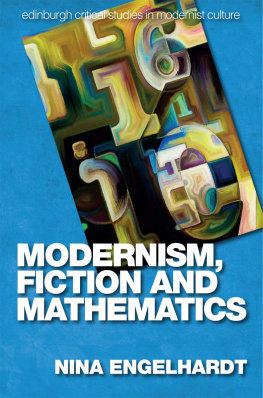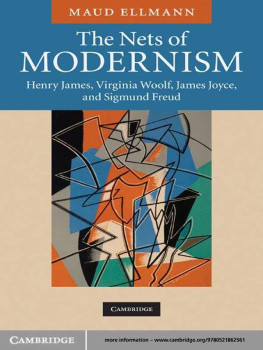modernism
modernism
Michael Levenson

Published with assistance from the foundation established in memory of Henry Weldon Barnes of the Class of 1882, Yale College.
Copyright 2011 by Michael Levenson.
All rights reserved.
This book may not be reproduced, in whole or in part, including illustrations, in any form (beyond that copying permitted by Sections 107 and 108 of the U.S. Copyright Law and except by reviewers for the public press), without written permission from the publishers.
Yale University Press books may be purchased in quantity for educational, business, or promotional use. For information, please e-mail sales.press@yale.edu (U.S. office) or sales@yaleup.co.uk (U.K. office).
Set in Minion and Nobel type by Integrated Publishing Solutions, Grand Rapids, Michigan.
Printed in the United States of America by Sheridan Books, Ann Arbor, Michigan.
Library of Congress Cataloging-in-Publication Data
Levenson, Michael H. (Michael Harry), 1951
Modernism / Michael Levenson.
p. cm.
Includes bibliographical references and index.
ISBN 978-0-300-11173-6 (alk. paper)
1. Modernism (Literature) I. Title.
PN56.M54L48 2011
700.4112dc22
2011014179
A catalogue record for this book is available from the British Library.
This paper meets the requirements of ANSI/NISO Z39.48-1992 (Permanence of Paper).
10 9 8 7 6 5 4 3 2 1
To my mother, Rose, and for my father, Howard
CONTENTS
INTRODUCTION
the spectacle of modernism
CHAPTER 1
the avant-garde in modernism
CHAPTER 2
narrating modernity: the novel after flaubert
CHAPTER 3
the modernist lyric i: from baudelaire to eliot
CHAPTER 4
drama as politics, drama as ritual
CHAPTER 5
modernism in and out of war
CHAPTER 6
the ends of modernism
introduction:
the spectacle of modernism
Modernism may have disappeared as a living cultural force, but it maintains its provocation for all who try to understand it. To live within our own modernity is to be anxious about our place in time, the future of culture, and the fate of the changes that the modernists sought to achieve.
This book offers a new account of Modernism. Thanks to the work of many scholars over the past two decades, it is now possible to offer a broader and more synthetic history than would have been possible in an earlier generation. In this respect, the present book is as much a tribute to the achievements of my contemporaries as it is the product of my own researches.
Any history, especially a history of Modernism, must begin with the myth of origins. Was there a first modernist? Even to pose the question is to hear the sound of folly. We look back to Edgar Allan Poe and further back to Lord Byron and then back again to Laurence Sterne. Franois Villon can be a precursor, as can Catullus or Petronius. Any distinguishing mark of Modernism, any sign or signature, such as discontinuity, collage, literary self-consciousness, irony, the use of myth, can be traced back to the furthest temporal horizon. To try to identify an elusive beginning or to propose clinching definitions is to play a game with changing rules. Yet even without boundaries and definitions, much needs to be said.
In European and American culture of the past two centuries a sense of rupture and novelty pervaded the collective consciousness. The reasons are familiar: revolutions in France and in America; the age of steam industry; railways; urbanization; class conflict; religious doubt; the spread of empire; the struggle between the sexes. These different dimensions of change followed varying historical pathways but converged and accumulated until the discourse of novelty became inescapable. An act of testimony often appeared in nineteenth-century life: an elderly individual would summon the memory of an entirely different world in childhood. The evocation of the landscape before the railways was one common figure. But the telling event came within the curve of a single life; the vivid contrasts between green and gray, slowness and speed, national unity and class conflict, occurred inside one living memory.
Modernity remains haunted both by a search for novelty and by the recollection of precursors. This double sense creates an abiding instability, a sense of modernity as inescapable but undecidable. Perhaps we are not modern, or not yet modern, even as we feel that we have crossed a threshold in history. Such undecidability is both a condition of our scholarship and the episode itself. As Susan Stanford Friedman has observed, Modernity is not solely a fixed set of characteristics that might have appeared in a given space and time, such as the European Enlightenment or the twentieth-century avant-garde in the arts. Nor is modernity exclusively the principle of rupture. Throughout the past two hundred years, we hear a breathless chanting of the word new and then the uncertain recall of precedents. We may take it as the fate of modernity that its origins must remain in question and that we can never be sure that it is a modernity. Even as we talk incessantly about living through new times, the origins of the newness are contested.
In an early essay, Richard Wagner in Bayreuth (1876), later published in Untimely Meditations, Friedrich Nietzsche unveiled a scene of revolutionary transformation. The theater of Wagner, the mythic musical grandeur of his operathis, says Nietzsche, was something altogether new, appearing with no warning signs, no transitional events.anticipates the rupture. For many things the time has come to die out; this new art is a prophet which sees the end approaching for other things than the arts (199). This rapturous embrace completes an exemplary modernist scene: a revolutionary philosopher recognizes his vision incarnated in revolutionary art. Nietzsche welcomes the creative destruction that will become a rhythm in modernist ambition. Set against a society organized around comfort and respectability, appetite and nostalgia, a true art will violently recover something ancient that has been forgotten, even as it creates something new that has never been anticipated. It will necessarily be out of harmony with its own time. All who attend the Bayreuth Festival, proclaims Nietzsche, will be felt to be untimely men: their home is not in this age but elsewhere (198). Even when he turns against Wagner, bitterly regretting the betrayal of vision, Nietzsche remains the partisan of untimely men and of radical renewal in the arts that will overturn the bases of culture.
Another performance shook the complacent at nearly the same moment. Henrik Ibsens A Dolls House, which appeared in 1879, created a notorious sensation in its final sequence. The decision of Nora Helmer to cross the threshold, leaving husband and children behind, was a reverberant act. The shock recurred two years later when Ghosts portrayed the mental dissolution of Oswald Alving, the too-young inheritor of his fathers syphilis. Ibsen was writing in a key sharply different from Wagners: his plays of the 1870s turn from mythic universality to the precision of the problem play. Between Wagnerian allegory and the Ibsenite topic stretches a vast distance, but both authors shared a contempt for the timid bourgeoisie. Between the strivings of Wagnerian love and the attack of the syphilis bacterium lies the wide terrain of modernist provocation.
But Ibsen and Wagner share something else. Their work confirmed the spectacle of modernity, the advent of successive and arresting artistic events, which fascinated, and often appalled, a rapt audience. Modernism needs to be understood not as an elite craft refined in secret but as a complex exchange between artists and audiences. Through the last half, and especially the last quarter, of the nineteenth century, a large, literate public found itself entreated and defied, encouraged and repulsed. The revulsion of many prepared the pleasure of some. Of all the artists of the nineteenth century, wrote one early commentator, Wagner and Ibsen stand out as the best hated. Byron and Shelley faced abuse only in England; Manet was hated in Paris; the controversy over Nietzsche was comparatively a local affair. But like Wagner, Ibsen received from all Europe fervent praise and The notoriety of these two artists, spreading so quickly, secured the image of modernism as an epidemic.
Next page

